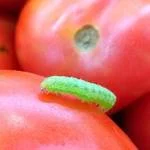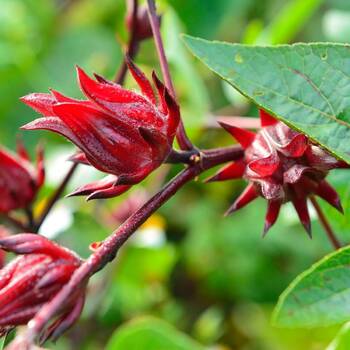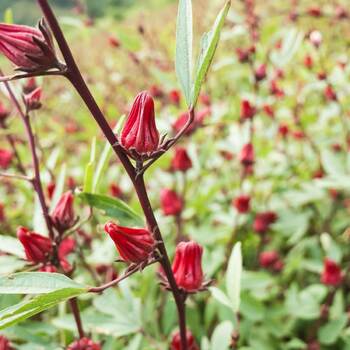
How to Grow Rosella Seeds
Grow Guide #2313
Family: Malvaceae
Binomial name: Hibiscus sabdariffa
Life Cycle: Annual
This 'How to Grow' guide details everything a home gardener needs to know to plant, grow and care for Rosella (Hibiscus sabdariffa).
When to Sow Rosella Seeds
Rosella is a warm season crop. Use the table below to identify the best time of year to sow rosella seeds in your climate.
Note: Rosella plants need warm soil to germinate and a growing season of at least 6 months of warm weather to produce fruit. Gardeners in cool climates need to start seeds indoors; using a heat mat to boost soil temperature can be beneficial.
| JAN | FEB | MAR | APR | MAY | JUN | JUL | AUG | SEP | OCT | NOV | DEC | |
|---|---|---|---|---|---|---|---|---|---|---|---|---|
| Cool | ||||||||||||
| Temperate | ||||||||||||
| Sub-Tropical | ||||||||||||
| Tropical | ||||||||||||
| Arid |
Preparation
Rosella plants are best grown in full sun. Choose a location that will receive at least 6 hours of full sun each day.
Rosella plants need a well drained soil enriched with plenty of organic matter. Prepare soil by weeding it thoroughly, digging it over to loosen it and adding aged animal manure or compost. Keep the area free of weeds until planting. Learn more about preparing soil for planting here.
How to Sow Rosella Seeds
Rosella seeds do not require any treatment (eg soaking, stratification) before sowing.
Rosella seeds grow best when they are raised in trays or other containers and transplanted to the garden once established.
- Fill trays, punnets or jiffy pots with a good quality seed-raising mix, or use soil starter pellets.
- Sow seeds 10mm deep.
- Keep soil moist but never wet or dry.
- Seeds should germinate in around 10-21 days at a soil temperature of 25-35°C.
- Transplant seedlings to the garden once they have their first true leaves and are large enough to handle (usually 5-10cm tall).
- Plant out, spacing plants 45cm apart, with rows 100cm apart.
Rosella is a tender crop that’s sensitive to frost. Do not transplant seedlings or sow seeds outside until all danger of frost has passed.
Optional: In cool climates rosella seeds can be sown indoors 6 weeks before the last expected frost. Grow them in a warm position with plenty of natural light.
How to Grow Rosella
Rosella plants may need watering during the growing season. Water when the soil is dry about 5cm below the surface (test this by scratching away a little soil with your finger). Water deeply in the early morning or late afternoon. Avoid watering the leaves of plants to avoid fungal diseases. Learn more about watering here.
If soil was well prepared no extra fertiliser should be necessary. In poor soil or to give your plants an extra boost, application of a balanced fertiliser or one formulated for fruit and vegetables can be beneficial:
- Apply slow release fertiliser at the recommended rate when transplanting or when seedlings are 5-10cm tall.
- Apply liquid fertiliser at the recommended rate and frequency while plants are fruiting or flowering.
How to Harvest Rosella
Rosella should be ready to harvest in approximately 180-200 days.
Rosella leaves are ready to harvest when they are young and tender, and can be harvested as needed. Pinch or snip them from the plant, harvesting the outer ones and leaving some on the plant for future growth. Eat leaves as soon as possible after harvesting. Store leaves short term in a perforated plastic bag in the fridge.
The calyxes (the outermost petals at the base of the flowers and fruit) are also harvested. After the flowers bloom they will fall off the plant, leaving the calyxes and seed pods (together called the 'fruit') to form.
Rosella plants have two flushes of flowers and fruit; the first flush will be relatively small but the fruit should be harvested to encourage a larger second flush later in summer.
Rosella calyxes are ready to harvest when they are shiny and plump. Older calyxes will become dry and stringy. Harvest the calyxes by cutting the whole fruit off with snips/secateurs to separate them from the stem. The fruit can be used whole or the calyxes can be separated from the seed pods. Harvested calyxes can be used fresh to make jams, jellies or cordial. To dry whole fruit, spread them on a wire rack or tray and dry them in the sun or using a food dehydrator.
Common Problems when Growing Rosella
Like all plants, rosella is susceptible to some pests, diseases and other problems. Below is a list of the most common problems gardeners encounter when growing rosella plants:
 Aphids are small (2-4mm long) sap-sucking insects that congregate on the new shoots or the undersides of leaves. They can cause leaves to wilt or become discoloured, and also excrete honeydew which can attract ants and other insect pests. To manage aphids, remove them by spraying with a garden hose, apply a soap or alcohol spray, or encourage predatory insects to your garden. Read more about aphids here.
Aphids are small (2-4mm long) sap-sucking insects that congregate on the new shoots or the undersides of leaves. They can cause leaves to wilt or become discoloured, and also excrete honeydew which can attract ants and other insect pests. To manage aphids, remove them by spraying with a garden hose, apply a soap or alcohol spray, or encourage predatory insects to your garden. Read more about aphids here. Armyworms, cutworms and other caterpillars can all eat the inside of fruit, making it inedible. Young caterpillars burrow into soft fruit, leaving just a small telltale hole on the fruit’s skin. Monitor fruit and remove any caterpillars you see. If necessary use insect exclusion netting or fruit bags to physically protect the fruit, or spray with Dipel.
Armyworms, cutworms and other caterpillars can all eat the inside of fruit, making it inedible. Young caterpillars burrow into soft fruit, leaving just a small telltale hole on the fruit’s skin. Monitor fruit and remove any caterpillars you see. If necessary use insect exclusion netting or fruit bags to physically protect the fruit, or spray with Dipel..jpg) Powdery mildew is caused by fungal spores reproducing on the leaves of plants. First showing as white spots on leaves, affected areas can spread quickly to cover the entire leaf surface. While rarely fatal, powdery mildew can reduce yields. Water plants at soil level (not on leaves) to prevent spreading spores, allow good air flow between plants, remove affected leaves and if necessary spray with an appropriate fungicide or homemade spray. Read more here about powdery mildew here.
Powdery mildew is caused by fungal spores reproducing on the leaves of plants. First showing as white spots on leaves, affected areas can spread quickly to cover the entire leaf surface. While rarely fatal, powdery mildew can reduce yields. Water plants at soil level (not on leaves) to prevent spreading spores, allow good air flow between plants, remove affected leaves and if necessary spray with an appropriate fungicide or homemade spray. Read more here about powdery mildew here.


.png)




